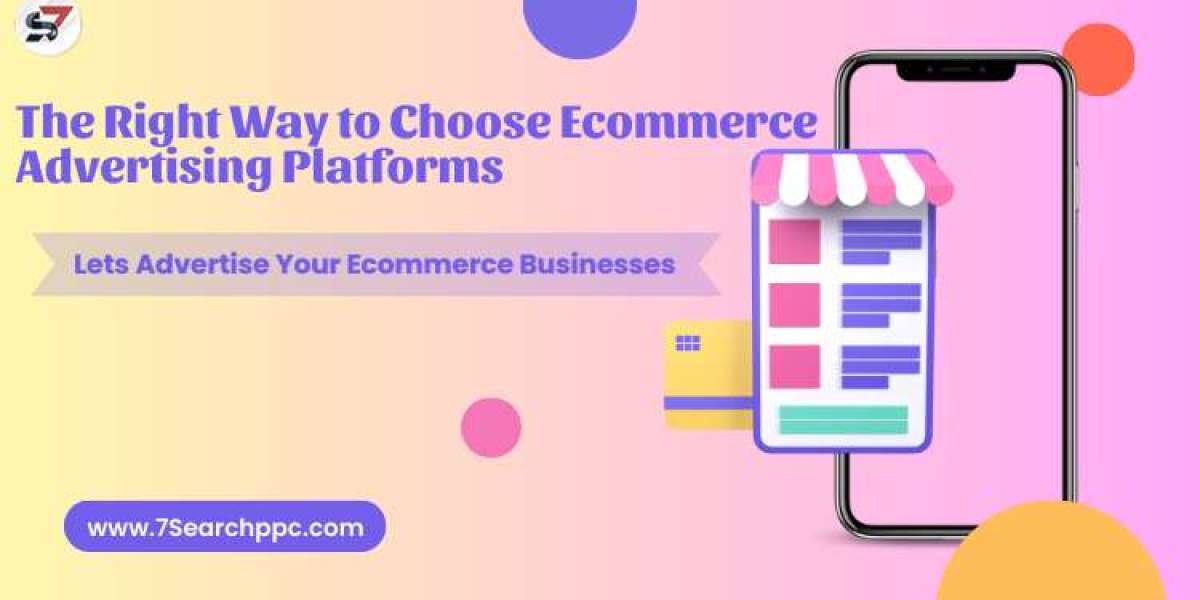In the fast-paced world of ecommerce, where competition is fierce and attention spans are short, choosing the right advertising platforms is critical to the success of your online business. Ecommerce advertising platforms serve as the bridge between your products and your target audience, making it essential to select the ones that align with your business goals and budget. In this blog, we will explore the right way to choose ecommerce advertising platforms that can propel your online store to new heights.
Understanding Your Business Goals
Before diving into the world of e-commerce advertising platforms, it's crucial to have a clear understanding of your business goals. Your advertising strategy should be aligned with your overall business objectives. Here are some common e-commerce goals:
Increasing Sales: If your primary goal is to boost sales and revenue, you should focus on platforms that have a strong track record of driving conversions.
Brand Awareness: If your brand is relatively new or you want to expand your reach, you might prioritize platforms that excel in creating brand awareness.
Lead Generation: Some businesses aim to capture leads and build a loyal customer base. In such cases, platforms that facilitate lead generation should be your focus.
Website Traffic: If your website needs more traffic to generate sales, platforms that can drive targeted traffic to your site are essential.
Understanding Your Target Audience
Knowing your target audience is another critical factor in choosing the right e-commerce advertising platforms. Different platforms cater to various demographics and interests. To effectively reach your audience, you must have a clear understanding of who they are and where they spend their time online. Consider factors such as:
Demographics: Age, gender, location, income level, and other demographic factors can influence your platform selection.
Interests: Understand your audience's interests and preferences. Do they prefer visual content on Instagram or engage more with professional content on LinkedIn?
Online Behavior: Analyze where your target audience spends most of their online time. Are they active on social media, search engines, or niche websites?
Exploring E-commerce Advertising Platforms
Now that you have a solid grasp of your business goals and target audience, let's explore some of the top e-commerce advertising platforms and their strengths:
1. Google Ads
Strengths: Google Ads is the go-to platform for search engine advertising. It allows you to display ads when users search for specific keywords, making it highly effective for capturing intent-driven traffic. You can also use Google Shopping Ads to showcase your products directly in search results.
Best Suited For: Businesses looking to capture high-intent traffic and drive immediate sales.
2. 7Search PPC
7Search PPC is a fantastic PPC advertising network for e-commerce businesses, offering a cost-effective way to promote ecommerce businesses.
7Search PPC is the best e-commerce advertising platform since it gives advertisers with a variety of features and ad types to help them achieve their goals more efficiently. Furthermore, 7Search PPC offers online store owners an excellent opportunity to market ecommerce websites and produce a continuous stream of cash. 7Search PPC's wide network and commitment to authentic traffic helps both publishers and advertisers.
3. Facebook Ads
Strengths: With a massive user base and extensive targeting options, Facebook Ads are excellent for brand awareness, lead generation, and retargeting. The platform also includes Instagram Ads, which can be beneficial for visually appealing products.
Best Suited For: Businesses aiming to build brand awareness, engage with a diverse audience, and retarget website visitors.
4. Instagram Ads
Strengths: Owned by Facebook, Instagram is a visual-centric platform ideal for businesses in the fashion, beauty, and lifestyle niches. It's effective for showcasing products through eye-catching visuals.
Best Suited For: Businesses with visually appealing products and a target audience that engages with visual content.
5. Amazon Advertising
Strengths: If you're an e-commerce business selling products on Amazon, Amazon Advertising is a must. It allows you to promote your products within Amazon search results and on product detail pages.
Best Suited For: Amazon sellers looking to increase product visibility and sales within the Amazon ecosystem.
6. LinkedIn Ads
Strengths: LinkedIn is the go-to platform for B2B businesses. It's excellent for targeting professionals and decision-makers. You can run sponsored content, InMail campaigns, and display ads to reach your target audience.
Best Suited For: B2B businesses looking to generate leads and build professional connections.
7. Pinterest Ads
Strengths: Pinterest is a visual discovery platform, making it suitable for businesses with visually appealing products or services. It's also known for its strong female user base.
Best Suited For: Businesses in fashion, home decor, DIY, and similar niches with visually compelling offerings.
8. YouTube Ads
Strengths: YouTube offers various ad formats, including skippable ads, non-skippable ads, and video discovery ads. It's an excellent platform for businesses that can create engaging video content.
Best Suited For: Businesses with the resources to create video content and engage their audience visually.
Setting a Budget and Measuring Success
Once you've chosen the best e-commerce advertising platforms, you must create a budget and key performance indicators (KPIs) to track your progress. Here are some budgetary and measuring points to consider:
Budget Allocation: Decide how much money you're willing to spend on advertising on each platform. Set your budget depending on your objectives and the platform's potential for ROI.
Conversion Tracking: Conversion monitoring may be used to determine the performance of your marketing. Set goals and track important online behaviours such as purchases, sign-ups, and downloads.
Monitoring ROI: Track your return on investment (ROI) for each platform on a regular basis. If a certain platform isn't producing the intended results, reconsider your approach or reallocate your funding.
A/B Testing: Use A/B testing to optimise your advertising strategies.
Test various ad creatives, targeting choices, and ad formats to see what works best for your target demographic.
Ad Schedule: Depending on your audience's behavior, consider scheduling your ads to run during peak times when your target audience is most active.
Adapting to Changing Trends
The e-commerce landscape is continuously changing, and advertising platforms alter their algorithms and features on a regular basis. Consider the following tactics to stay competitive, adapt to shifting trends, and maximise your advertising ROI:
Keep Up to Date: Follow industry news and updates about advertising platforms on a regular basis. This will allow you to keep ahead of the curve and capitalise on new features.
Iterate and experiment: Experiment with different ad forms, targeting choices, and techniques without fear. What works now may not work tomorrow, so be flexible.
Feedback from the audience: Pay attention to what your audience says. Engage with consumer comments and reviews to learn about their wants and requirements.
Competitor Analysis: Monitor your competitors' marketing strategies. Analyse what works for them and look for ways to differentiate your brand.
Decisions Based on Data: Based on the performance of your efforts, make data-driven decisions. Use analytics tools to learn what's driving success and what needs to be improved.
Conclusion
Choosing the right e-commerce advertising platforms for your business is a crucial step in achieving your goals and reaching your target audience. Start by aligning your advertising strategy with your business objectives and understanding your audience. Then, explore the strengths of different platforms and select the ones that best suit your needs. Remember to set a budget, track your performance, and adapt to changing trends to stay competitive in the dynamic world of e-commerce advertising. With the right strategy and platforms, you can effectively promote your products or services and drive growth for your e-commerce business.
Read More
13 Best E-commerce Advertising Platforms: Exploring Ad Solutions
A Quick And Simple Guide To Choosing The Right E-Commerce Platform For Your Business








